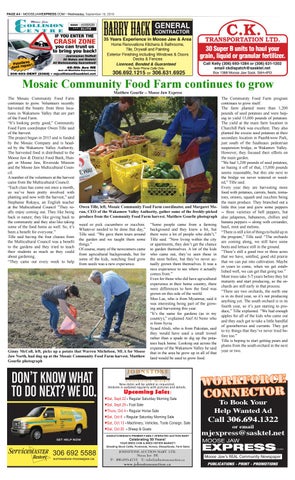PAGE A4 • MOOSEJAWEXPRESS.COM • Wednesday, September 19, 2018
35 Years Experience in Moose Jaw & Area Home Renovations Kitchens & Bathrooms, Tile, Drywall and Painting Exterior Finishing including Windows & Doors Decks & Fences Licenced, Bonded & Guaranteed No Texts Phone Calls Only
306.692.1215 or 306.631.6925
C.K.
TRANSPORTATION LTD.
30 Super B units to haul your grain, liquid or granular fertilizer. Call Kelly (306) 693-1284 or (306) 631-1202 email ckdispatch@sasktel.net Box 1388 Moose Jaw Sask. S6H-4R3
Mosaic Community Food Farm continues to grow Matthew Gourlie -- Moose Jaw Express
The Community Food Farm program continues to grow itself. The farm planted more than 1,200 pounds of seed potatoes and were hoping to yield 15,000 pounds of potatoes. The yield at the main farm location in Churchill Park was excellent. They also planted the excess seed potatoes at their secondary location in Paashkwow Park, just south of the Saulteaux pedestrian suspension bridge, in Wakamov Valley. However, they focused their efforts on the main garden. “We had 1,200 pounds of seed potatoes, so basing it off of that, 15,000 pounds seems reasonable, but this site next to the bridge we never watered or weeded,” Tille said. Every year they are harvesting more food with potatoes, carrots, beets, tomatoes, onions, squash and zucchini being the main produce. They branched out a Owen Tille, left, Mosaic Community Food Farm coordinator, and Margaret Mo- little this year and grew some peppers ran, CEO of the Wakamow Valley Authority, gather some of the freshly-picked -- three varieties of bell peppers, but produce from the Community Food Farm harvest. Matthew Gourlie photograph also jalapenos, habaneros, chillies and banana peppers -- along with coriander, weed or pick cucumbers or zucchini. “Some people came from a farming basil, mint and melons. Whatever needed to be done that day,” background and they knew a bit, but “There is still a lot of things to build up in Tille said. “We gave them tours around there were a lot of people who didn’t,” the program,” Tille said. “The orchards the garden and we taught them some Tille said. “Now living within the city are coming along, we still have some things.” or apartments, they don’t get the chance beets and lettuce still in the ground. Of course, many of the newcomers came to garden themselves. A lot of the kids “There’s still a good two or three acres from agricultural backgrounds, but for who came out, they’ve seen these in that we have, untilled, good old prairie some of the kids, watching food grow the store before, but they’ve never acthat we can put into cultivation. Maybe tually grown them themselves. It was a from seeds was a new experience. in years to come, when we get estabnice experience to see where it actually lished well, we can get that going too.” comes from.” Most trees take 5-7 years before they hit Even for those who did have agricultural maturity and start producing, so the orexperience in their home country, there chards are still early in that process. were differences to how the food was “There are two orchards, the north one grown on this side of the world. is in its third year, so it’s not producing Moo Lae, who is from Myanmar, said it anything yet. The south orchard is in its was interesting being part of the growfourth year, so it’s just starting to proing and harvesting this year. duce,” Tille explained. “We had enough “It’s the same for gardens (as in my apples for all of the kids who came out country),” explained Atef Al Nemr who and they each got to take a little handful is from Syria. of gooseberries and currants. They got Syaed Abidi, who is from Pakistan, said to try things that they’ve never tried bethey would have used a small trowel fore too.” rather than a spade to dig up the potaTille is hoping to start getting pears and toes back home. Looking out across the plums from the south orchard in the next expanse of the Wakamow Valley he said Ginny McColl, left, picks up a potato that Warren Michelson, MLA for Moose that in the area he grew up in all of that year or two. Jaw North, had dug up at the Mosaic Community Food Farm harvest. Matthew land would be used to grow food. Gourlie photograph The Mosaic Community Food Farm continues to grow. Volunteers recently harvested the bounty from three locations in Wakamow Valley that are part of the Food Farm. “It’s looking pretty good,” Community Food Farm coordinator Owen Tille said of the harvest. The project began in 2015 and is funded by the Mosaic Company and is headed by the Wakamow Valley Authority. The harvested food is distributed to the Moose Jaw & District Food Bank, Hunger in Moose Jaw, Riverside Mission and the Moose Jaw Multicultural Council. A number of the volunteers at the harvest came from the Multicultural Council. “Each class has come out once a month, so we’ve been pretty involved with planting and now with the harvest,” said Stephanie Rokaya, an English teacher at the Multicultural Council “They really enjoy coming out. They like being back in nature; they like giving back to the community and they also like taking some of the food home as well. So, it’s been a benefit for everyone.” Tille said having the four classes from the Multicultural Council was a benefit to the gardens and they tried to teach their students as much as they could about gardening. “They came out every week to help
WORKFORCE CONNECTOR To Book Your Help Wanted Ad
Call 306.694.1322 or email
mjexpress@sasktel.net
